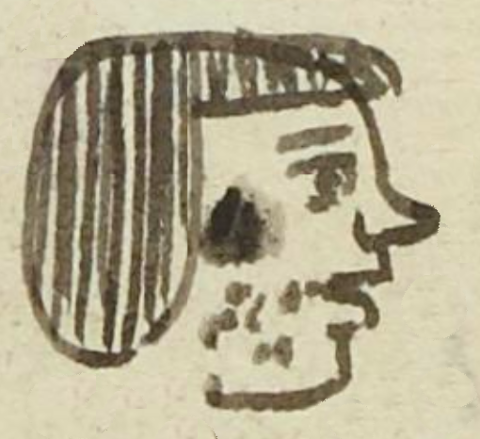Ixtlil (MH626r)
This black-line drawing of the compound glyph for the personal name Ixtlil (perhaps "Black Face") is attested here as a man's name. It shows the head of a man in profile, looking toward the viewer's right. A large black (tlilli) spot appears on the man's cheekbone, not on the eye, which pushes the reading more toward face than eye. The term ixtli can refer to either eye or face. Below the large black dot are some additional, smaller dots, perhaps representing freckles or moles.
Stephanie Wood
Ixtlil seems to mean more “Black Face” than “Black Eye,” but it could be either. This name may be be short for Ixtlilton, “Little Black Face,” the name of a deity or divine force, also known as Tlaltecuin or Tlaltetecuini, "Earth-Stamper,” who, as we note in the Online Nahuatl Dictionary, “belonged with the Macuiltonaleque, the young solar deities who presided over flowers, feasting, singing, dancing, gaming, and painting and who bore the names of the five tonalpohualli (260-day religious divinatory calendar) days assigned to the south, with numerical coefficients of five (the number signifying ‘excess’). Their most prominent member was Macuilxochitl, ‘Five Flower.’" [See: Fray Bernardino de Sahagún, Primeros Memoriales, ed. Thelma D. Sullivan, et al. (Norman: University of Oklahoma Press, 1997), 101.] One also wonders if this name could be an apocopation of the fuller name, Ixtlilxochitl, associated with rulers of Tetzcoco.
Stephanie Wood
partasal
yxtlil
Baltazar Ixtlil
1560
Jeff Haskett-Wood
colors, colores, negro, caras, faces, black, nombres de hombres, cara negra, Ixtlilxochitl, ixtlilmaca

ix(tli), face, eye, https://nahuatl.wired-humanities.org/content/ixtli
tlil(li), the color black or black ink, https://nahuatl.wired-humanities.org/content/tlilli
ixtlilmaca, to have or wear (literally, to give) black paint on one's face, https://nahuatl.wired-humanities.org/content/ixtlilmaca
Cara Negra
Stephanie Wood
Matrícula de Huexotzinco, folio 626r, World Digital Library, https://www.loc.gov/resource/gdcwdl.wdl_15282/?sp=334&st=image.
This manuscript is hosted by the Library of Congress and the World Digital Library; used here with the Creative Commons, “Attribution-NonCommercial-ShareAlike 3.0 License” (CC-BY-NC-SAq 3.0).










